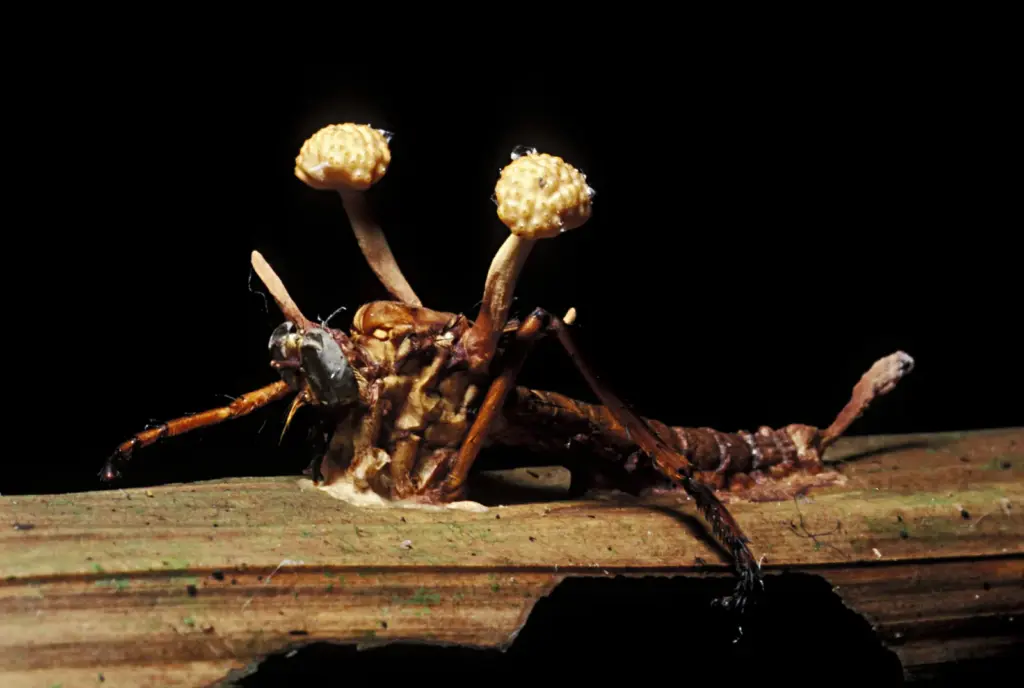Let’s be honest – who watched HBO’s hit The Last of Us without feeling a bit twitchy about fungi afterward? The terrifying scenario – humans taken over by parasitic fungi, transforming into zombie-like creatures – might seem wildly fictional. Yet, science tells us that the eerie inspiration behind the show isn’t entirely fabricated. Meet the real-world puppet master: Ophiocordyceps unilateralis, affectionately (or maybe not-so-affectionately) known as the zombie-ant fungus.
Zombie Fungus: Nature’s Dark Puppet Master
This unsettling fungus is no amateur in the world of parasitic horror:
- Hijack Mode Activated: Spores attach to the ant’s exoskeleton, infiltrating their victim. Enzymes punch through the tough shell, allowing the fungus to invade from within.
- Mind Games: The fungus starts to produce chemical compounds, hijacking the ant’s nervous system and compelling it to behave erratically – climbing high vegetation, completely against its instincts.
- The Final Grip: The poor ant bites down onto a leaf with a literal death grip. Locked in place, it’s the perfect spot for the fungus’s sinister next phase.
- Fungal Finale: Post-mortem, a gruesome stalk erupts dramatically from the ant’s corpse, dispersing spores to infect even more unsuspecting insects.

But Could Humans Be Next?
The leap from ants to humans might seem small for a gripping TV storyline, but biology suggests it’s no easy jump. Let’s break down why humans probably won’t be overtaken by fungi anytime soon:
- Picky Parasites: Ophiocordyceps evolved specifically to dominate ants. Its finely-tuned mechanisms aren’t suited for humans or even mammals at large.
- We’re Hot (Literally): Humans run warm – around 37°C (98.6°F). Most fungi prefer cooler climates. Our body heat is a built-in fungal firewall.
- Supercharged Immune Systems: Our immune defenses are quite good at squashing fungal invaders. Compared to ants, humans are walking fortresses.
Still, hold off on celebrating just yet. Scientists point out that fungi are incredibly adaptive. So, could any fungus potentially make the jump to us?
Rising Temperatures, Rising Concerns
Climate change introduces a wrinkle in this fungal fear-fest:
- Candida auris Alert: Already making headlines, this fungus thrives at human body temperature. Resistant to drugs, it’s a legitimate medical threat. Some experts suspect global warming is giving fungi the evolutionary nudge needed to tackle warmer, human-sized hosts.
- Adaptation Warning: If temperatures keep rising, more fungi might adapt to higher heat. That’s not fantastic news for humanity, making the plot of The Last of Us feel uncomfortably plausible.
Mind-Control Fungi Are Real (Sort Of)
Before total panic sets in, remember that mind-controlling fungi aren’t unique to ants:
- Massospora cicadina: This fungal villain infects cicadas, releasing psychoactive compounds (including the famed psilocybin from magic mushrooms). Infected cicadas go wild, helping spread fungal spores even further.
- Spider-Manipulators: Gibellula fungi target spiders, driving them to behave oddly before their demise. Scotland recently discovered such fungi lurking in its forests, proving this phenomenon isn’t confined to tropical zones.
Cordyceps: Friend or Foe?
Curiously, not all Cordyceps interactions with humans spell doom:
- Ancient Medicines: In Asia, Cordyceps sinensis—the caterpillar fungus – is hailed for its health perks, boosting everything from energy levels to libido.
- Potential in Cancer Treatment: Research hints at anticancer properties hidden within some Cordyceps species, potentially revolutionizing future therapies.
So, while your nightmares might feature clickers chasing you through post-apocalyptic streets, real-world Cordyceps might ironically help humanity rather than destroy it.
Bottom Line: Are We Facing a Fungal Apocalypse?
Short answer: Probably not. Longer answer: Science keeps us cautiously optimistic. The specialized nature of zombie-ant fungus means it’s not jumping to humans overnight. However, the broader fungal world is constantly evolving. The rise of drug-resistant fungi and changing climate conditions mean we shouldn’t get overly complacent.
But don’t barricade your doors yet – at least, not because of fungi. The Last of Us might be compelling, brilliant fiction, but it’s still just that: fiction.
Still, there’s always tomorrow’s scientific discovery. And who knows what lies ahead in nature’s endless creativity – after all, reality often ends up stranger than fiction.





